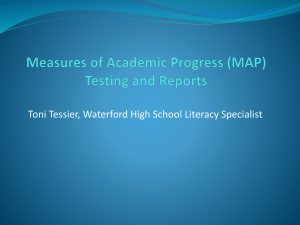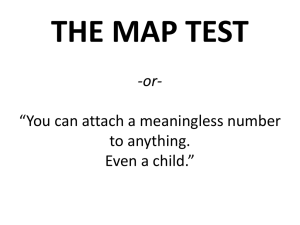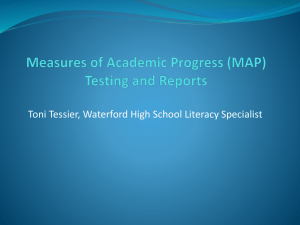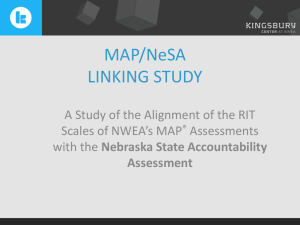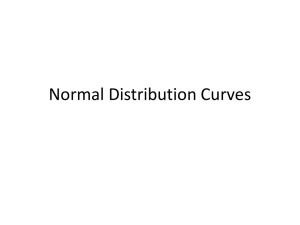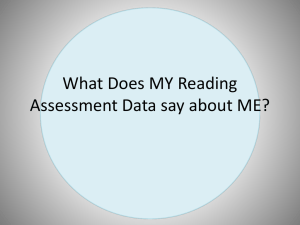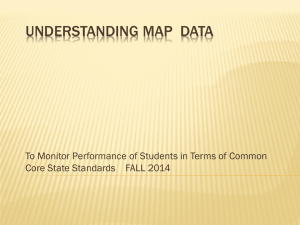(MAP) Testing and Reports - Waterford Public Schools
advertisement
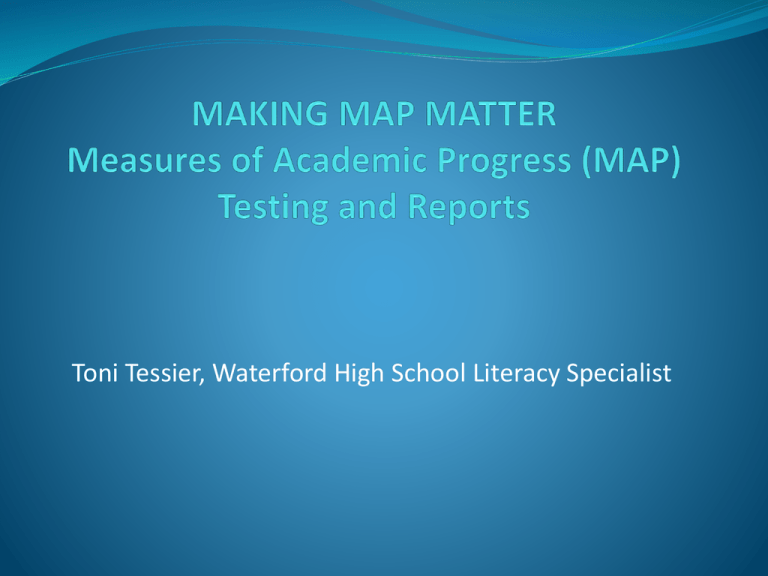
Toni Tessier, Waterford High School Literacy Specialist MAP Presentation Agenda • • • • Introductions PowerPoint Overview of critical MAP reports Using MAP to plan reading and math instruction/matching readers to text Application-Teachers access data and curriculum ladders in order to plan instruction MAP Test Basics A non-profit organization comprised of educators and researchers called the Northwest Evaluation Association (NWEA) developed the MAP test. The MAP test is a computer-based, adaptive test that determines a student’s instructional level in the areas of reading, language usage and math. Types of Tests There are two types of tests: Survey (about 20 minutes/20 questions) gives an overall score but no breakdown by goal area-very useful for placement/guidance department, may be a good mid-year check Survey with goals (about 50 minutes/42-64 questions) provides an overall score and goal area scores-more informative for instructors WPS 2012-2013 School Year Grades 9, 10 fall, winter and spring Grade 8 Winter Grade 5 Spring * Selected grade 11, 12 students College Readiness Assessment MAP Test in Depth Scores are reported on a Rasch Unit (RIT) scale. The scale is an equal interval scale that shows growth over time. The scale is independent of grade level. RIT scores range from about 150 to 285. There are differences among Math, Reading and Language Usage RIT scores. The highest score for math is about 285, reading is about 260 and Language Usage is about 255. More Information When determining a student’s performance level, it is important to look at the norms for each grade level or the percentile range (found on the teacher reports and class by subject reports).*See Comparative Data to Inform Instructional Decisions The reading test also gives a Lexile Level for each student. Correlation to CMT: NWEA claims that MAP test scores are a reliable predictor of CMT performance (80 to 90 percent accurate). Scores below 40th percentile considered Basic/Below Basic Scores above 75th percentile considered Goal/Advanced Comparative Data: Reading Comparative Data: Math “40th Percentile Score” by Grade Level (based on Fall 2011 norms) Students achieving at the 40th percentile or higher on the MAP test are likely to be proficient or higher on our current state testing. Here are the 40th percentile RIT scores for Reading. Reading “Cut” Scores Seas Kdg on G1 G2 G3 G4 G5 G6 G7 G8 G9 G 10 G 11 F 140 157 172 186 196 203 208 212 215 217 219 219 W 148 167 180 191 199 206 210 214 217 218 219 220 S 154 173 186 195 203 208 212 216 218 219 219 220 “40th Percentile Score” by Grade Level (based on Fall 2011 norms) Students achieving at the 40th percentile or higher on the MAP test are likely to be proficient or higher on our current state testing. Here are the 40th percentile RIT scores for math. Math“Cut” Scores Seas Kdg on G1 G2 G3 G4 G5 G6 G7 G8 G9 G 10 G 11 F 140 159 175 189 200 209 215 221 226 229 229 231 W 147 169 182 195 205 214 219 224 228 230 230 232 S 152 175 188 199 209 217 221 226 230 231 231 233 Correlation to Common Core Standards Representatives from NWEA helped create the standards Smarter Balanced Assessment Consortium (SBAC) using the same adaptive approach New enhanced test items will be introduced this year The future for MAP? We Err on the Side of Caution Thankfully, our students perform better on the CAPT than projected by MAP. We chalk this up to our preparation before the tests, including our intervention classes. However, the fortieth percentile is also a bit conservative. Cohort MAP Reading % Below Proficiency CAPT Reading % Below Proficiency MAP Math % Below Proficiency CAPT Math % Below Proficiency 2011 Cohort 13 (Winter) 7 26 (Winter) 9 2012 Cohort 14 (Winter) 7 13 (Winter) 7 How We Are Using the MAP Scores: MAP is our high school universal screening test (along with CMT and CAPT). Students who score below the 40th percentile in reading or math are closely monitored for 6-8 weeks in the Tier I “Intensive” setting. CFA’s, quizzes and tests will confirm areas of weakness and indicate if progress is occurring. Students may then be placed in Tier II or III interventions if needed (Literacy Lab, Math Lab, Writing Workshop or English Workshop). MAP scores would also be used to exit students from Tier II and Tier III interventions. MAP scores are also being used to inform instruction in the classroom. The score breakdowns can specify specific areas of strength and weakness for individuals and classes. This can lead to differentiated instruction in the classroom. How We Are Using MAP, continued MAP scores are being used in PPT’s/annual reviews. Guidance counselors are using the survey tests to accurately place new students. They are also finding the tests helpful for conflicts with teacher vs. parent or student course placement recommendations. English department studied the average RIT scores at each level course. MAP Reports: There are a variety of reports that teachers may find useful in determining strengths and weakness of a particular class or a particular student. Immediate results are seen first by the students. Time taken to complete the test is not recorded online. Reports can be accessed 24 hours after students have taken the tests by visiting www.nwea.org. Important Reports Teacher Reports: These reports allow you to see a table of your class listing overall scores and goal area scores (which relate to CT or CCS standards) for each subject. What questions do you have? How could teachers and others use this report? What problems would you anticipate with teachers using these reports? Differentiating Instruction Using the data from the teacher report, a teacher selects four different texts at four different Lexile levels that share a similar theme. Students read articles at their instructional levels and report unique information from their texts in small groups in which each member has read a different text. Students are given tasks to complete during or after reading a instructionally-appropriate text that vary based on individual skills they need to practice. For example, In a group one person may summarize the text, one may fins the main idea, another may analyze the author’s purpose . Class By Subject: This report provides a table of student scores in reading, language usage or math. Sort the list by name or score. Grade By Subject: Look at the scores of an entire grade by subject. Sort by name or score. Class By RIT: See a breakdown of the RIT scores of each student in your class for all three tests. Click on a test to see the RIT ranges for only that subject. Once you are there, you can click on a student’s name to bring up a chart from the Common Core State Standards DesCartes framework. The chart has three columns. Concepts in the left-hand column are concepts a student has probably mastered. Concepts in the middle column are concepts that meet the instructional level of the student, and the right-hand column contains upcoming concepts to introduce. *See sample DesCartes chart Class Rosters Class Rosters: This allows you to view and print individual student progress reports for all of the subject areas for one student or for the whole class. Examine the table and graph versions of the report. Which do you prefer? Why? How might you be able to use this information with students and parents? What questions do you have? What might you ask the student? Dynamic Reports: Several reports may be accessed in this section. Teacher Class Overview: This test shows if/how students are growing. A list of instructional activities and strategies beyond the classroom is also available. This report also projects CMT performance Lexile Report: This shows the range of Lexile levels within a class. There are resources available on the Internet to compile book lists and print full-text articles based on Lexile levels. -Great Free Resource Go your school’s homepage and click on the Iconn.org (Ct. State Reseach site) Student Projected Performance*: This allows teachers to see who is projected to be proficient on each of the tests. Student Goal Setting Worksheet*: This is a good document for conferencing with students and sharing their test results. -This provides a “typical growth” number aligned with an individual’s RIT score. Comprehensive Data File After a testing season is complete, you may request a raw data file. This file can be converted to Excel. We used this file to enter all of the scores into INFORM and our own spreadsheets for analysis. How you will use this: - Use this to triangulate data. - For example, you could create an Excel sheet that synthesized and correlated Practice CAPT, MAP and CAPT data. - Since there is no “search by student feature” on the MAP website, this might be a quick way to look up a student without having to consult PowerSchool - -Use this to look at factors such as gender, special education designation or race and ethnicity. How to use the Data to provide targeted instruction: Keep it simple. Use the Class by RIT report to identify the weakest areas for your class or student. Look at the DesCartes chart for that weak area and decide how it relates to the most important parts of your curriculum ( power standards). Focus on one or two skills you can work on that relate to a current unit of study. You may prefer the layout of fortheteacher.org’s NWEA Curriculum Ladders rather than the DesCartes charts. Student Motivation Students should understand the adaptive nature of the test Students should know the reasons for the test Student goal-setting/ Involve them in the process Avoid test fatigue/over-testing Consider ways classroom teachers could offer incentives Issues/What to Think About: Empowering students to do their best Making the test matter Teacher preparation Time SEED Your Task(s) Choice 1: Determine a student’s Reading RIT score Copy and paste the Reading Ladders sections that corresponds to the student’s score into a new document. Consider the current unit of study, your own knowledge of the student and your goals Based on your preference, bold or underline a couple of areas of focus for your student. Choice 2: Determine the Lexile Level of a student or group of students. Use the Iconn.org site to find reading materials for an upcoming lesson. Contacts: Waterford High School Phone- 860.437.6956 Toni Tessier, MAP Coordinator ext. 761 Email addresses: ttessier@waterfordschools.org Other Local Districts Colchester New London
